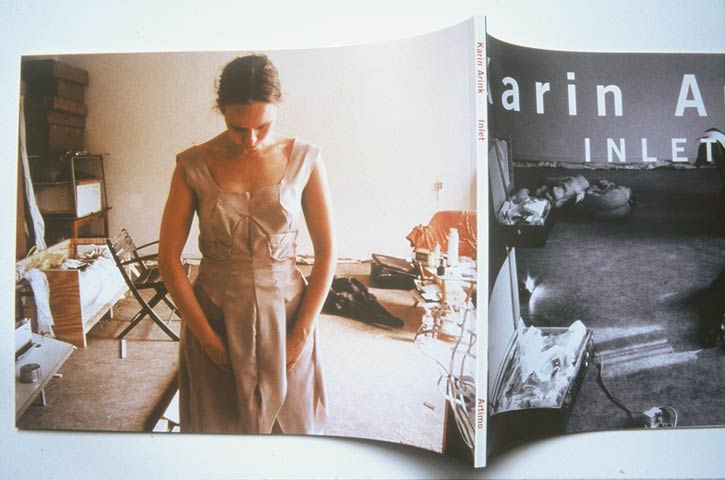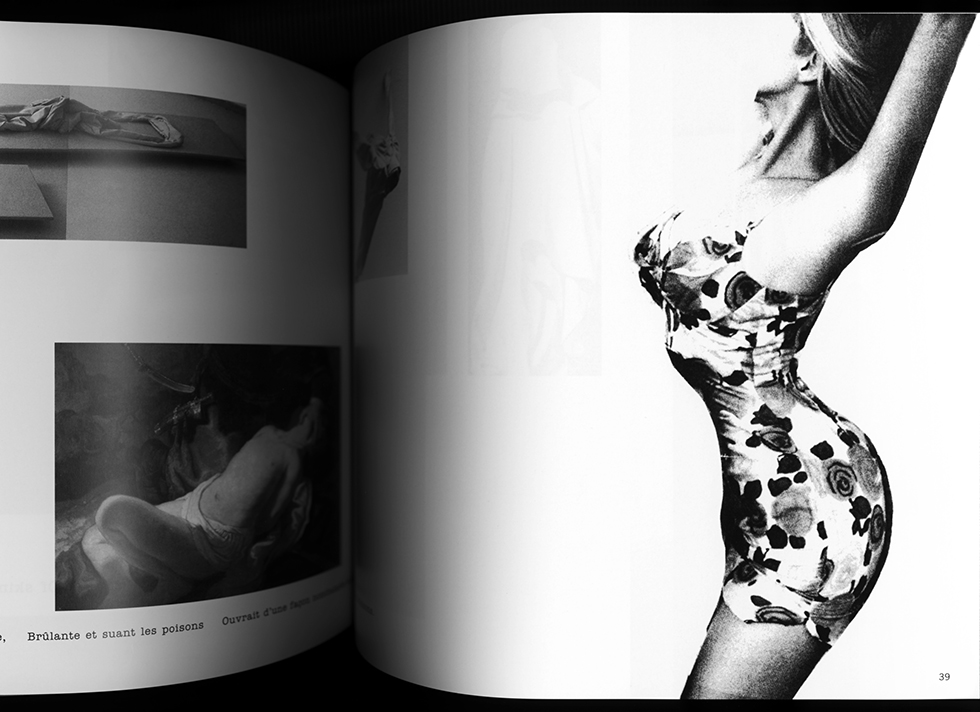Inlet
A-Z
cover of the publication ‘Inlet - such stuff as thoughts are made of’ 1997
a source book compiled by me,
published by Artimo Amsterdam
on the front page my studio, on the left suitcases full of porcelain ‘inner space’ fragments 1996
on the back side the only full-colour image: ‘one-piece at home’ 1997
inside, placing my works alongside yours and yours and yours
like here:

with images from a Rembrandt and an ad for jeans
inspiration for my work ‘niké’ 1992
related work: ‘J M O I U J - tekens tussen jou en mij’ 2005 / ‘Enka text improvs’ 1999 /
introduction text (english version), written by me january 1997:
Welcome to this book.
It’s rather unusual for an artist to write the introduction to a book on his or her own work. Often this is a job done by an interested observer, describing his own ideas, associations and stories related to the work. But I’ve decided to take a different route.
I want to show you the words and images that are in my head, the ones that inspired me, that influenced my vision of art and gave it shape. I hope that after reading and looking at this book, you will have a broader understanding of my work and the ideas lying behind it.
My work is rooted in what I know and think and believe. My work is always based on sensations that I have experienced, but I am becoming increasingly aware that I would never have taken that sensation seriously if it weren’t connected to one or more ideas.
It is difficult to know where my ideas for a sculpture or drawing or movement come from. Does such an idea spring from a sudden realization that the position I happen to be in as I stand up or lie down possesses some kind of charge that belies its own simplicity? Where does the charge come from - is it only from my personal experience?
Sometimes there’s a phrase, a scene from a dance performance or a film, that puts one small and inherently simple experience in the context of other ideas, causing it to reverberate with meaning; sometimes it’s just the sudden physicality of an idea that I find fascinating, and sometimes it’s the way all my thoughts and experiences can splinter apart into contradictory fragments. But what is this, I keep asking myself: personality, person, identity? Of all my experiences, all my thoughts, what is the most essential ‘me’? And of all my outer manifestations, my body, my gestures, my clothing, my behaviour, the things that keep changing depending on my mood and on the group with which I am associating - what manifestations best reveal who I am?
My work is an investigation of the extent of my domain.
The first thing that came to mind was what takes place in my head: my thoughts, given shape by language. As a child I was obsessed by language. My goal in life was to equal the verbal virtuosity of my mother, with her sentences full of colourful invented expressions. I immersed myself in the stories I read, the stories I wrote and those that I dreamed. I took pleasure in the power of words, I believed them, even against my better judgement, and I absorbed them into my thinking.
But in secondary school I began to see the sharpness of words, their treacherousness - in gossip, in friendships, in verbal harassments, in political discussions. I noticed that words can tempt you to say things louder than you intended to, that a felicitous phrase can change the entire direction of your essay. I learned that my control of language is limited.
I was also struck by how quickly my ideas and opinions could change under the influence of other people’s eloquence. Both language and ideas turned out to be nothing but thin ice, and I’ve never been one for skating…
So I turned to the body. Its seemingly unambiguous physical presence attracted me. Contrary to my changing thoughts, my body seemed solid and stable: a rock that I could build upon. Perhaps the body, my outer shell, is the shape that defines my person….
But although I could examine the outer borders of my body with relative ease by using different media to explore its contours, it wasn’t long before I realized that I don’t know what’s inside my body, under the skin. Perhaps my solid exterior was built on shifting sand…
I had to know what’s going on inside my body, so I put my feelings and senses to work. In my first year at the art academy I began studying improvisational dance. There I learned to direct my attention to internal physical sensations: the tension in my muscles, the extent to which I stretched my arm, the twisting of my torso. I practiced in order to activate my inner sensors, to become acquainted with my muscles, nerves and bones from the inside out. But the body turned out to be no less ambiguous. Physical sensations that seemed simple at first glance turned out to be increasingly complex. The experiences of my body parts became more and more detailed, causing me to feel the tension of a muscle before I felt the whole arm. My body quickly disintegrated, broken down into specific details, but luckily this gave me the illusion that I was getting to know my subcutaneous body better and better.
It was an illusion, of course. Because it wasn’t long before I realized that what I was feeling was a projection, the combination of a vague sensation and a half-forgotten knowledge of anatomy. I can never really know what’s going on under my skin. My body is impenetrable, and on further reflection it’s not very reliable either. It creates millions of cells and then destroys them, all without my knowledge, and when I try to imagine my body as it really is from the inside, I see a vast, endless, dark space before me where trillions of cells live without being the least bit aware of me.
And then I realized that I don’t only experience reality with my senses; my physical experiences are partly defined by my ideas about body and personality, and vice versa. During dance improvisations I have learned that certain movements impose on the dancer or actor a quality that is located more in the movement itself than in the actual personality. But though the movement can be totally alien to the dancer, the experience of that quality still becomes part of the dancer’s experiences. The feelings that some movements evoke become a part of myself, they influence my emotions and ideas. And the same is true for all the other information that I allow in.
There are no lines of division that separate my thoughts, the words that I read, the images and the dance that I see, the music that I hear, the physical experiences that I undergo. My thoughts and feelings, the images, drawings, movements and texts that I produce - everything together forms an inextricable tangle, everything influences everything else. Everything that I see and experience influences both everything that I will experience and how I interpret my past experiences.
In short, I went to discover a domain that I can call my self, but the only thing I found was a tangle of influences and experiences that are barely controllable or recognizable…. But this doesn’t worry me: the things that I make are a result of all my investigations into this tangle, and I can live with the idea that these investigations are what make me me.
This book is an attempt to make part of the tangle visible. Unfortunately, there are parts of the tangle that can hardly be captured on paper, if at all: the little jerk-like hand motions of a dancer in a piece by De Keersmaeker, the inner resonance of Bach’s cello suites, intense conversations with friends, the adrenaline that comes from working together, the projects I realized in conjunction with the B.a.d Foundation and NEsTWORK, and much more.
I’ve had to limit myself to images and text. And even then I’ve had to leave many things out: I don’t have a good photo of many beloved images, and some images or texts did’t seem to fit into the web as it developed on paper. I have tried to arrange the materials that lent themselves to this publication in such a way that the book conveys the significance that these texts and images have for me and my work.
Enjoy yourselves!
1996-1997
other publications: ‘Ik besta daar waar jij mij aanraakt’ 2000 / ‘Karin Arink - States of Self’ 2008 /